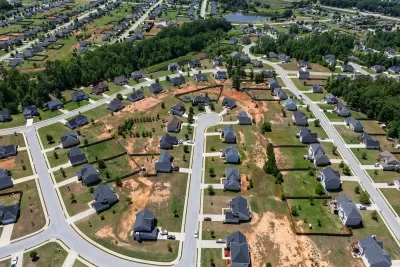How making residential building requirements more flexible can ease the housing crisis and make neighborhoods more livable for more households.

In a piece for Strong Towns, Ben Abramson explains why minimum lot size requirements often stifle new housing development and lead to higher housing costs and a dearth of affordable housing for smaller households.
Advocates for incremental development suggest that cities should adjust their zoning codes to allow for more flexible, affordable development that makes use of existing infrastructure to increase the housing supply, eliminating expensive approval processes whose costs get passed on to buyers. “Enabling a fee-simple transaction lets buyers own the dirt under their property and gives underwriters greater confidence in its viability. The more ways your community can enable builders to develop housing options with fee-simple sales, the faster they can address North America’s glaring housing shortage.”
Portland, Oregon developer Neil Heller says incremental development, such as building multiple housing units or subdivided homes on single-family zoned lots, doesn’t bring about the massive changes some people fear. “Yes, you do notice change, but it's almost imperceptible … the average person just going down the street would probably not even notice what's going on in the backyard.”
Some cities, such as Austin and Houston, have reduced minimum lot sizes as part of zoning reforms to both encourage denser, more walkable development and boost the housing supply.
FULL STORY: How Minimum Lot Size Requirements Maximize the Housing Crisis

Alabama: Trump Terminates Settlements for Black Communities Harmed By Raw Sewage
Trump deemed the landmark civil rights agreement “illegal DEI and environmental justice policy.”

Planetizen Federal Action Tracker
A weekly monitor of how Trump’s orders and actions are impacting planners and planning in America.

Why Should We Subsidize Public Transportation?
Many public transit agencies face financial stress due to rising costs, declining fare revenue, and declining subsidies. Transit advocates must provide a strong business case for increasing public transit funding.

Understanding Road Diets
An explainer from Momentum highlights the advantages of reducing vehicle lanes in favor of more bike, transit, and pedestrian infrastructure.

New California Law Regulates Warehouse Pollution
A new law tightens building and emissions regulations for large distribution warehouses to mitigate air pollution and traffic in surrounding communities.

Phoenix Announces Opening Date for Light Rail Extension
The South Central extension will connect South Phoenix to downtown and other major hubs starting on June 7.
Urban Design for Planners 1: Software Tools
This six-course series explores essential urban design concepts using open source software and equips planners with the tools they need to participate fully in the urban design process.
Planning for Universal Design
Learn the tools for implementing Universal Design in planning regulations.
Caltrans
Smith Gee Studio
Institute for Housing and Urban Development Studies (IHS)
City of Grandview
Harvard GSD Executive Education
Toledo-Lucas County Plan Commissions
Salt Lake City
NYU Wagner Graduate School of Public Service





























